Bamboo Shrimp is a fine-looking freshwater species kept in the aquarium. They are popular among Aquarists because of their calm, peaceful nature and bright colors. The Bamboo Shrimp come in different sizes with various colors, and they don’t require much maintenance. Apart from various essential aspects of popularity, these shrimps are readily available in Asia, Europe, and the United States.
However, if you want to dig deep about bamboo shrimps, this article is just for you. Let’s discuss everything about bamboo shrimp, such as their appearance, diet, requirements, breeding, tankmates, and many more in the article below.
Table of Contents
Bamboo Shrimp: Complete Guide
Bamboo is a freshwater species, admirable yet strange for several aquarists. However, they are available in freshwater worldwide, their native home in Sri Lanka, Malaysia, Thailand, and Okinawa.
In addition to that, Bamboo shrimp are also considered native to Southeast Asia. They call it “ The Asian Filter Shrimp” and enjoy it as a delicacy in Asia. Besides, Bamboo shrimp come in small, medium, and large sizes and are a perfect fit for all kinds and sizes of aquariums.
Let’s see a picture of a Bamboo Shrimp in an aquarium.
“The Asian Filter Shrimp” is sold anywhere between $10-$20. Furthermore, they are readily available in several local and chain shop markets all over South East Asia. They’re generally seen in red-brown color with wooden striping down their sides.
However, our article will illuminate various essential aspects of Bamboo shrimp for you to know and understand before choosing them as aquarium pets. So, without further ado, let’s get started.
Bamboo Shrimp: Overview
Bamboo shrimp are a very common species of freshwater aquarium shrimp that are mostly found in Southeastern parts of Asia and are also called Asian Filter Feeding Shrimp, Singapore Shrimp, Singapore Wood Shrimp, Wood Shrimp, Singapore Flower Shrimp, Flower Shrimp and Atyopsis moluccensis which is their scientific name. This type of freshwater shrimps can be found in aquarium stores, even though these are not as common as dwarf shrimp.
The Bamboo shrimp are the quietest, most peaceful, neat species, making them more appealing to keep in aquariums. Moreover, they are not violent and exciting to watch in the water tank. That is why one can keep Bamboo Shrimp with snails, dwarf shrimp, and other nonviolent fishes.
Now, the harmless Bamboo Shrimp possesses another striking feature: instead of claws, they have 4 pairs of fans. They use these fans to capture small food particles in flowing water and then pass them into their mouths. Additionally, bamboo shrimps can change their colors during the breeding period. They are available in various colors like red, white, green, blue, etc.
Bamboo Shrimp are always fun to observe, especially when they try to grab food and climb on each other playfully without any harm. Their striking colors and calm nature make them more famous as peaceful aquarium species day by day.
Moreover, when they’re collected from the wild, their temperature ranges between 18-20 degrees celsius. However, these shrimps in freshwater aquariums can have a more comprehensive range of temperatures from 20-22 degrees celsius.
When buying these shrimp pay attention to their activeness and choose the ones that are well behaved and very active. Preferably choose shrimps that have all their limbs, but if one or a few limbs are missing then it is not a serious problem. You can buy shrimp even with some missing limbs because these limbs will grow back after some time.
Now, let us quickly understand more about Bamboo Shrimp with a chart provided below.
| Information Chart | Bamboo Shrimp |
| Scientific Name | Atyopsis moluccensis |
| Family | Atyidae |
| Other Names | Fan Shrimp, Filter shrimp, Wood Shrimp, Timber Shrimp, Asian Filter Shrimp, Singapore Shrimp, Mountain Shrimp, Marble Shrimp, Rock Shrimp, Flower Shrimp, and Maluku Shrimp. |
| Homeland | Indonesia (Bali, Sumatera), Sri Lanka, Thailand, Philippines, Malaysia, Okinawa. |
| Care Level | Easy to medium |
| Temperament | Peaceful |
| Color | Red, brown, creamy white, green, and blue |
| Lifespan | Up to 2 years or more than that |
| Size | 2 to 3 inches |
| Diet | omnivore/ detritivore |
| Minimum Tank Size | 10 gallons |
| Temperature | 22- 28°C (70-88℉) |
| Water Conditions | Fresh water in the tank |
| Tank Mate Compatibility | Peaceful and nonviolent community |
| Optimal TDS | 150-200 (100-300) |
| Nitrate | Less than 20ppm |
Appearance of Bamboo Shrimp
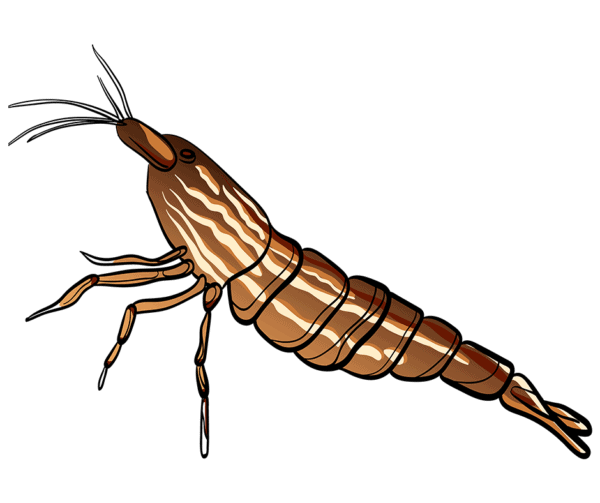
Bamboo Shrimp poses an impressive look in terms of appearance and not all bamboo shrimps look alike. They look different from each other, depending on which area they belong. Bamboo shrimp grow up to a size of 2-5 inches and live about 2-3 years. They are very colorful, and their color goes from red to brown with a white line on its back.
Their colorful features can easily enhance the overall aesthetic look of your aquarium tank. They come in various colors, mostly red, brown, creamy white, green, and blue. However, you can understand their mood by paying attention to their body colors, which change according to their health and state.
If you notice your Bamboo Shrimp changing to orange, it certainly indicates they’re having some sort of lousy health; when they look pale, it means they are under stress or they are not responding correctly to the water change in the tank. However, when you spot a white line then kudos, your shrimps are happy!
Another interesting fact about this shrimp is that these shrimps have 3 feathery fans and a couple of long sensory antennas, also they have compound eyes like many other shrimp species. With the help of their ‘fans,’ they catch food by holding the fans against the water flow.
Once they capture the food particles, they pass the collected food into their mouths. They can also sense their environment with their sharp eyestalk and antennae.
Furthermore, the body’s outer layer consists of a carapace, a hard shell designed to protect the body. They have 6 abdominal sections with enough flexibility to flex the abdomen. Surprisingly, the tail is the sixth part of the Bamboo Shrimp.
Bamboo shrimp: Male And Female Recognition
There is some difference between male and female Bamboo Shrimp. Those subtle differences are:
- The male Bamboo Shrimp is usually a few inches bigger than the female.
- Male Bamboo Shrimp possess a giant leg (the first pair) than females.
- The male and female Bamboo Shrimp have different sexual openings. For the female, the small opening (Gonopores) is in the third pair, whereas the male is in the fifth pair.
- Female Bamboo shrimp have a large abdomen while the male has a slim one.
The Lifespan Of Bamboo Shrimp
These colorful and calm natured Bamboo Shrimps are easy to maintain as they require little care. The typical lifespan of a Bamboo shrimp is 2 to 3 years. However, when properly looked after, their lifespan improves. If Bamboo Shrimp get a proper environment to grow, they can last up to 5 to 6 years, but that’s very rare.
Besides, they are delicate, and it’s not uncommon for them to die while introducing them to newer water tanks. This happens due to their weak nature; the stress and shock, while being transferred into a newer water environment, cause them to die.
Bamboo Shrimp Size
Bamboo Shrimp are tiny aquarium species requiring little space in the water tank.
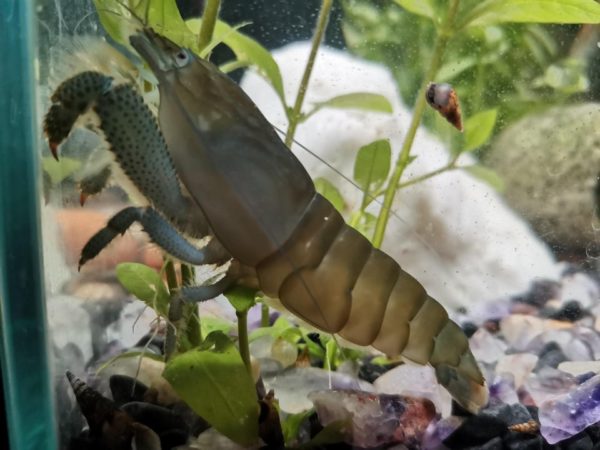
However, the typical bamboo shrimp grows up to 2 inches on the lower end and 3 inches for larger specimens. In addition to that, they can grow larger than 3 inches in a few cases. However, it is essential to maintain their health to keep them active all the time.
Natural Habitat And Origin
The Atyopsis moluccensis or Bamboo Shrimp are from tropical climate areas like Sri Lanka, Japan, Indonesia, Malaysia, and Thailand. They prefer slow-flowing rivers, unlike other shrimps. And if you are interested in keeping them for your aquarium, you must recreate their natural habitat; otherwise, they’ll have a hard time surviving in different water environments.
Moreover, maintaining them is not an easy task.
However, to recreate their natural habitat in your water tank, you need to pay attention to the quality of the aquarium’s freshwater. And for doing that, ensure that the aquarium’s water is a bit hard and receives optimal light, just like the tropical freshwater.
You also need to keep the pH level between 6.5 to 7.5.
Understanding their natural habitat is extremely important to keep the Bamboo shrimp healthy and active. Hence keep a good eye on the water type before petting these tropical bamboo shrimps.
Bamboo shrimp color changes
Usually, Bamboo shrimps are red and brown, sometimes they can be redder and sometimes more brown. Sometimes these shrimp can turn into the color of green, orange or yellow. After molting they have a light brownish color. Do not worry when you notice that your Bamboo shrimp is changing its color as these changes in color are pretty normal and make these shrimps more interesting.
Overall Bamboo shrimp will be good for those who like to see changes in their aquarium, as these fish are prone to color changing. Also, it is very interesting to watch the behavior of these shrimps, the way they breed, molt, eat and much other fun stuff. They are also perfect for those who do not want to take much responsibility as Bamboo shrimps are very easy to take care of. Hope this article was informative for you and now you will have a better idea about Bamboo shrimp.
Bamboo shrimp Care And Tank Set-Up
As mentioned earlier, Bamboo Shrimp involve burden-free maintenance and are easy to handle. Though they are delicate, they do not require any special treatment like other species. However, all they want is their natural habitat to live in. Hence maintaining their natural habitat is necessary to keep them healthy.
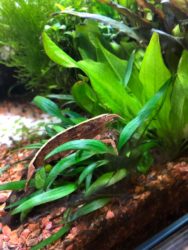
We recommend you follow up with regular water checks, as this is the main element of Bamboo shrimp care. Also, they are prone to excessive copper, hence avoiding copper-related substances in the aquarium tank.
Copper is toxic to the shrimps, not in their food but in water. People usually misunderstand the toxicity of copper present in water with essential copper present in shrimp’s food, which is required for its growth. Also, make sure that you use Bamboo Shrimp ‘safe’ plant fertilizer.
Another thing to pay attention to is the Bamboo shrimp movement. For instance, if you notice them hiding under any plant or rock for a long time during feeding time, it is a sign that something is incorrect.
Further, if they remain in the same manner for a more extended period, re-check the water parameter. Make sure other elements in the water tank and the substrate quality are OK. You should be extra careful while feeding them, and regarding what to feed how much to feed, we will let you know that in a while.
Bamboo shrimp Tank Size And Specifications
Now, another crucial factor in keeping your Bamboo Shrimp healthy is the water tank aspect. Many people are unaware that the water tank aspect plays a huge role in its long-lasting lifespan.
The aquarium should be layered with the substrate. Now, the substrate is essential to provide a well-pleasant habitat for your shrimps. In this case, you can use fine sands too.
Let’s know about the tank size and other specifications in elaboration.
Optimum Tank Size For Bamboo Shrimp
The minimum tank size for Bamboo Shrimp is 10 gallons; on the other hand, the optimum tank size should be 20 gallons of freshwater. In addition, to make the water tank suitable for Bamboo Shrimp, you can decorate it with rocks and plants after layering with a suitable substrate. It will help them in climbing to collect food.
Apart from that, you should add some plants in the water tank as these are beneficial for Bamboo Shrimp, and they love plant-based food. Bamboo Shrimp prefer living with plants in the aquarium as it provides them ample space to climb and hide.
Furthermore, using different rocks, especially lava rocks, can also be helpful for them.
Let’s see a floating Bamboo Shrimp.
Tank Shape For Bamboo Shrimp
The tank size matters most for Bamboo shrimp, and a 10 gallongallons water tank is better. However, the perfect water tank for Bamboo shrimp is 20 gallons. That said, a bigger tank will undoubtedly provide more flow in the tank, which they prefer.
Moreover, the bigger water tank can aid Bamboo Shrimp in supporting their food needs. Although constantly moving water is ideal for them, it is better to prefer a 20 gallons long tank than any other one.
Filter Type
According to several reports, a filter is necessary while cleaning the Bamboo Shrimp water tank. Although, Bamboo Shrimp loves sponge filters more than any other filters. They can use the sponge filter for sitting on them while having food. Besides, the sponge filter provides inlet currents to create enough water movement in the aquarium, which Bamboo Shrimp requires.
Additionally, make sure there is plenty of light in the aquarium.
Substrate
Bamboo Shrimp requires a layered substrate on the tank floor. You can use gravel or fine sands as the substrate. Substrate plays an essential role in maintaining shrimp’s optimum health. You should maintain the aquarium’s temperature from 75 to 81°F. And set the pH level to 6.5/7.0 to 7.5.
How Many Bamboo Shrimp In 20 Gallons?
Bamboo shrimp are fun to watch, and their calm and relaxed nature makes them favorable among several aquarists. Usually, they prefer a long tank of 20 gallons with the current. And in 20 gallons of the water tank, you can put one Bamboo Shrimp; hence, for every additional Bamboo Shrimp, add 20 gallons more.
Water Parameter For Bamboo Shrimp
Maintaining Bamboo Shrimp is not much; however, one needs to maintain consistency. The Bamboo shrimps are delicate, and even a slight change can harm them.
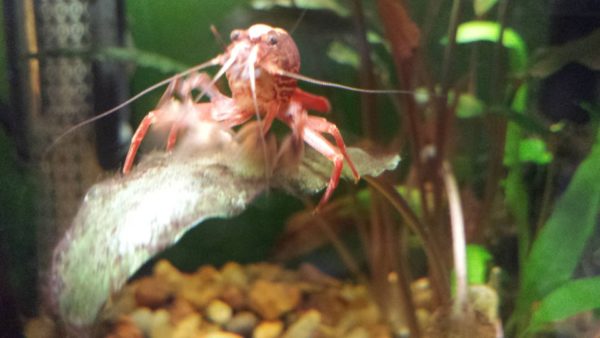
Water Temperature
Knowing the ideal water temperature is essential to keep Bamboo Shrimp fit. So, the ideal water temperature in the aquarium should be 70℉ to 78℉.
Water pH Level
Maintaining the required pH level of the water tank is essential, and failing to do that, can lead to severe issues with your Bamboo Shrimp. Hence, the perfect water pH level for Bamboo shrimp is 6.5 to 8.
Water Hardness
The suitable water parameter is needed for the Bamboo shrimp to survive in the water tank; the freshwater should be slightly hard, i.e., from 3 to 10 dKH.
Bamboo Shrimp Tank Landscape
Tank setting for Bamboo Shrimp is another crucial part. Bamboo shrimp are vegetarian. They eat plants in the water tanks. So, to set the tank, you require a good current in the tank, substrate, and sponge filters. You may add another air pump, and the temperature should be 75 to 82℉.
Live plants are essential for hiding, playing, feeding, and sleeping; therefore, plants in the water tank resemble their natural habitat. However, for decorating, you can use rocks and driftwoods too. The lightning should be bright in the tank.
The Diet Of Bamboo Shrimp
Many aquarists are not aware of the diet of Bamboo shrimp. Bamboo Shrimp are filter feeders, implying they can filter out their food from the water tank. Mainly, they prefer fish food, microorganisms, plant debris, microalgae, and other floating things in the aquarium. Moreover, you need to avoid adding extra supplements as their food in the tank.
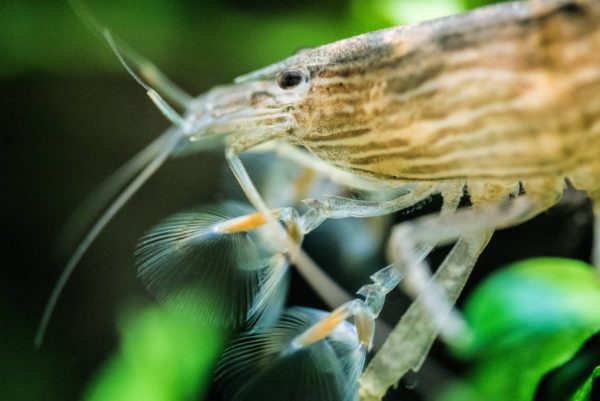
Bamboo shrimp do not feed from bottom left food and normally these are shrimps that feed on filter and they usually stand in the current without moving for many hours so the small particles can stick to their fans. You can feed them by putting powdered food in the stream that can flow straight to their fans, these food can be baby shrimp food, crushed fish flakes and algae powder. If you notice that your shrimp get dirty too fast and there are too many powdered food floating around then it is better to get some “cleaner” tankmates. Or if you notice that bamboo shrimps start digging the substrate in order to find food then it is time to feed them more.
How Often Should You Feed?
You should typically feed the Bamboo shrimp every once a day; however, this varies depending on the tank size and the size of the Bamboo Shrimp.
Bamboo Shrimp Behaviour And Temperament
Bamboo Shrimps are very peaceful animals. They remain active throughout the day. So, individuals get entertained while watching them play; children most importantly enjoy their funny and intoxicating moves inside the water tank. They are often playful, and that is noticeable. They do not harm other species in the water tank.
Are Bamboo Shrimp Lone Or Societal In Nature?
Bamboo Shrimp are calming in nature, and they can go along with each other well. Although they are a bit solitary species, they get along well too. And this happens because of their filter-feeding nature.
Bamboo shrimp Tank Mates
As previously mentioned, Bamboo Shrimp are well behaved and live peacefully with their tank mates. First of all, you should keep your Bamboo shrimp in groups, where they feel safe. Bamboo shrimp need tankmates that will not be dangerous for them as they are very week and peaceful shrimps. For example out of shrimp species dwarf shrimp can make them good tank mates and all types of snails can be good too. Let’s read the article further to get a comprehensive understanding of who can live with Bamboo shrimps.
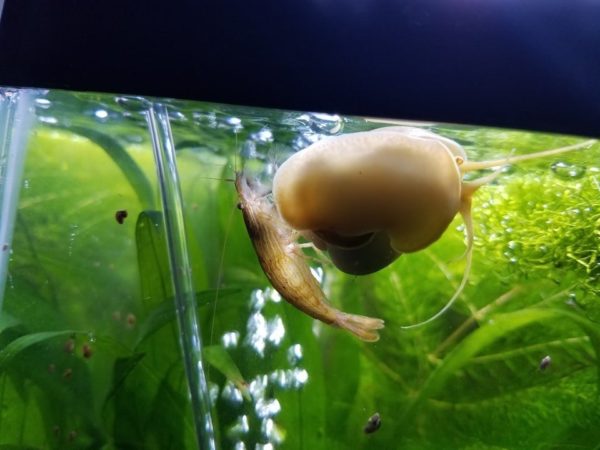
Ideal Bamboo Shrimp Tank Mates
The ideal Bamboo Shrimp are Vampire Shrimp, Amano Shrimp, Ghost Shrimp, Japanese Trapdoor Snails, Malaysian Trumpet Snails, Gold Inca Snails, Ivory Snails, Mystery Snails, Nerite Snails, Cory Catfish, Rabbit Snails, Assassin Snails, Otocinclus Catfish, and Ramshorn Snails.
Bad Tank Mates For Bamboo Shrimp
Bamboo Shrimp are non-aggressive species, so they do not have claws to protect themselves. Hence try to keep them separately, away from Goldfish, Oscars, Jack Dempseys, and other Cichlids as they can eat Bamboo Shrimp.
Breeding
Breeding Bamboo shrimp can be a little difficult. Baby Bamboo shrimp are born as larva and need to live in a very salty water to survive, you need to transfer them into salty water immediately where they can grow and look like adult shrimps and after that, you need to transfer them back to fresh water. Seems challenging but it is something that every shrimp keepers can do.
Facts About Bamboo shrimp
- Bamboo Shrimp do not require much as they are straightforward to keep, but still, they require some effort. The aquarium for this should be 76 L or more and should be very similar to their natural habitat with a strong filter and a wood or a wood-like stick so the shrimp can stand the water flow. The water pH level should be about 6.5-7.4, and the nitrites and ammonia should be 0ppm. The temperature in the aquarium should be a minimum of 73 F and a maximum of 82 F. Also, the aquarium should have many hiding spaces such as Bamboo shrimp molt and change their exoskeleton with a new one. When the new one appears, they need hiding spaces for a few days until the new exoskeleton becomes firmer. Overall these shrimp are very easy to take care of as they adapt to any aquarium.
- Another essential factor about Bamboo shrimp requirements that you should pay attention to is copper. Like most freshwater aquarium shrimps, copper can be very dangerous for Bamboo shrimp; thus, you have to avoid using copper in your tank. Also, pay attention to plant fertilizer pellets, and once you plant them in the substrate, they can dissolve slowly, so you should be careful. When the substrate moves, dissolved pellets stir up and release everything in them into the water column. These filter-feeding shrimps may consume a large amount of copper concentration in water, eventually becoming poisoned. Hence keep the water free from copper, as it is toxic to Bamboo shrimps.
- It can lead to poisoning in the Bamboo Shrimp.
- Another essential thing about Bamboo shrimp that you need to pay attention to is when they hide for a long time. They can be hiding under plant leaves, behind the rocks, or anywhere they can hide. During preparation for molting, this is pretty much normal behavior. But be careful as this may also mean that something is wrong. If this continues for a more extended period, check the water parameters. Anything wrong with the water parameters can reduce Bamboo shrimps activity.
Are Bamboo Shrimp Right For You?
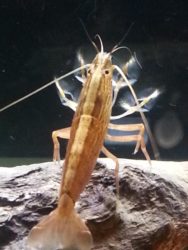
To be honest, Bamboo Shrimp are ideal for keeping as fish filters in any Aquariums. They are non-violent and can be kept with other species in the tank. Furthermore, they do not require high maintenance and are of hassle-free nature. Hence, you can consider adding them to your aquarium to enhance its beauty and filter out your aquarium tank.
FAQ
Do Bamboo Shrimp Eat Other Shrimp?
Bamboo Shrimp are peaceful and non-aggressive, implying that they are not predators but detritivores. They only prefer food particles in the water tank. However, they sometimes can eat their molts, but they are unlikely to eat any other shrimp or live prey present in the water tank.
Are Bamboo Shrimp Hard To Keep?
Well, Bamboo Shrimp are not hard to keep but easy and quick to maintain. However, it is highly recommended that the Aquarists measure the food in the initial days to avoid shortages of food kind of problems later. And do follow the other instructions too.
Can I Keep One Bamboo Shrimp?
Well, honestly, having a Bamboo Shrimp sounds suitable for anyone. If you are interested, you can keep one Bamboo Shrimp in a 20 gallons water tank. However, to add another Bamboo shrimp, you’ll require an additional 20 gallons of fresh water to create a suitable natural habitat.
Conclusion
Bamboo Shrimp are easy to keep and available in different colors. So, indeed, you can add them to your water tank as they are the most non-aggressive species you would get.
No related posts.
